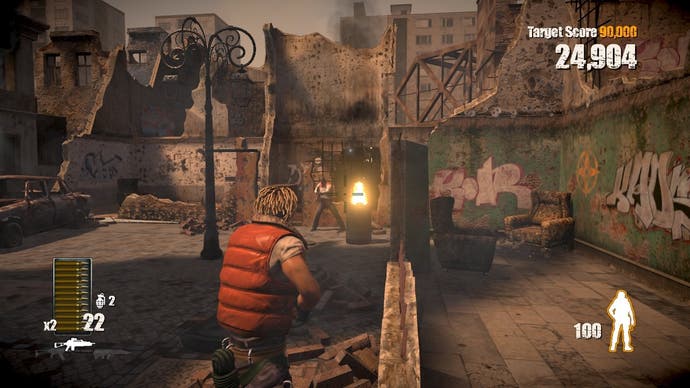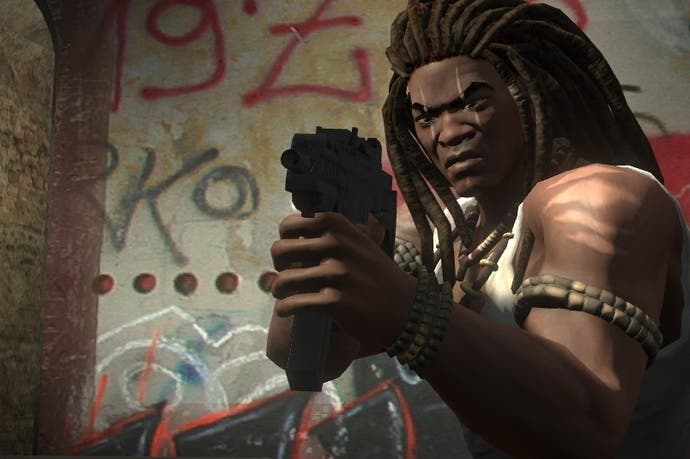The Club retrospective
If you like a lot of chocolate on your biscuit.
Most modern shooters go out of their way to provide a narrative justification for their eight hours of explosions and headshots. In 2008, Bizarre Creation's The Club barely even bothered.
An opening cinematic took less than two minutes to introduce you to a cast of eight playable characters and The Club itself, with little time left over to establish your motivation. So instead of narrative, it was the game's mechanics that compelled you kill. And rather than repelling invaders, overthrowing a tyrant, or restoring the honour of your clan, The Club had you killing for points.
For every disposable goon you gun down, the eponymous club - a secret society with a penchant for bloodsports - would reward you with a truckload of points and your in-game multiplier would increase. Since a hefty multiplier is the surest path to leaderboard domination, you soon find yourself sprinting through the stages, scanning frantically for another grunt to dispatch, in a constant, desperate bid to prevent that precious multiplier from draining away.
Your objective may be simple, but The Club is a tricky game to pin down. It's a weird melting pot of genre conventions, an exuberant crossbreed that, for some reason, is wrapped in the bland trappings of a gritty third-person shooter. First and foremost, it's a score attack, and The Club is designed to reward skilful play. Headshots prompt gruff congratulatory announcements, while long-range sharpshooting is recognised with a generous helping of bonus points. In order to post a competitive score, The Club demands fast, accurate gunplay.
But there's a racing game hidden beneath The Club's grimy façade too. Each of the eight burly murderers on offer have varying speed, strength and stamina stats, and you'll steer them through linear levels - memorising routes, perfecting your approach, and reaching for the restart button should you veer too far from the racing line.
In time attack levels, these mechanics are brought right to the fore, as you race against the clock to complete laps of dilapidated prisons, crumbling stately homes, and beached luxury liners. Even the game's single player campaign - the Tournaments - shares more structural DNA with Mario Kart than Gears of War, each collection of levels playing out like a murderous grand prix in which you jostle for leaderboard position.
Matt Cavanagh was The Club's Lead Designer, and he refers to the title unequivocally as "a racing game with guns." But that's not the only bit of genre splicing at work in The Club. Cavanagh explains that The Club's unobtrusive narrative and brief, character-specific ending cinematics were designed to be reminiscent of a fighting game.
"But if I could compare it to any one thing, I'd compare it to a speedrun," Cavanagh continues. "If you do a Doom speedrun, you play it over and over again, and that's what The Club is really. It's playing the level over and over again and learning it to perfection."
At launch, this focus on mastery proved divisive. The game all but demanded repeat play, and this, combined with the game's spartan environments and threadbare story, left some feeling that The Club was more like a firing range than a modern shooter.
According to Cavanagh, that's exactly how the game started out, emerging from a prototype that - thanks to time constraints - didn't have any enemy AI. "We still wanted to prove these interesting shooting mechanics we had," Cavanagh explains, "so we thought, why don't we make a literal shooting gallery? You know, where you have pop-up targets. We had this little story that ran in this disused warehouse, and instead of enemies you would shoot these pop-up targets that would literally swing out - like the start of Point Break."

For Bizarre Creations' founder and creative director Martyn Chudley, this prototype showed promise worth pursuing. Six months later, Matt Cavanagh and his team were prototyping again - this time with instructions to create a shooter built around scoring rather than story. A new prototype was built, and while this one featured enemy AI, it was kept deliberately basic. After all, The Club is a game about expert execution, and rather than matching wits with enemy tacticians, it was decided that players should be able to reliably anticipate where their victims would be lying in wait.
At this stage, The Club's gameplay - from its shooting mechanics to its scoring system - was complete. Its cast of playable killers and secret society backstory, however, hadn't even been considered yet, and the prototype's character models were essentially "men made out of cardboard boxes". Cavanagh and co. had decided to pursue a strictly 'gameplay first' approach, and the team dedicated itself to carefully refining that gameplay before all else.
This, as it turns out, is not the best way to attract a publisher. Plenty stopped by to see Bizarre Creations' latest project, but the blocky visuals and context-free shooting wasn't a tempting proposition for the visiting suits. "Sega saw through that," explains Cavanagh, "and I think that's because there are a lot of gamers at Sega, including the executives. At the time, that's not the way that a lot of publishers worked. Most of them weren't gamers, they were businessmen."
With funding in the bag, Cavanagh and his team had to take their cardboard box prototype and turn it into a viable product. Although Cavanagh recalls that The Club's development was largely plain sailing, the modular manner in which it was created - gameplay first, with a backstory and aesthetic bolted on later - undoubtedly left its imprint on the final product.
I ask Cavanagh about the most obvious example of this disconnect - the strange mismatch between The Club's boisterous gameplay and its dark, faintly dreary aesthetic. "Well, you are shooting people for points," Cavanagh counters. "We were quite cautious of the fact that we could've made it really grotesquely violent - and it probably would have sold better, actually. But we didn't want to make that, because we wanted something more towards the arcadey end of the scale." It's a shame, frankly, because a little cartoon gore might have helped The Club stand out at retail. Instead, this genuinely innovative game went to market dressed in the borrowed robes of a derivative blaster.
An over-familiar aesthetic wasn't The Club's only misstep either. Although Bizarre Creations will be remembered as a developer of world-class racers, its "racing game with guns" had terrible handling. The aiming itself was sharp and responsive, but characters turned at a positively glacial pace, which occasionally made for frustrating failures.

Getting snagged on the scenery as you turn a corner is no way to miss out on a record-breaking time-attack run. And while Bizarre Creations would go on to put your friends' high scores front-and-centre in Geometry Wars 2, this social focus didn't find its way into The Club. Sure, you could dive into the menus to view friends list leaderboards, but The Club never fostered the same sense of social competition that Geometry Wars 2 managed just one year later.
Given The Club's unique blend of successes and shortcomings, I ask Cavanagh if he's ever given much thought to a sequel. His reply is an instant "Oh God yeah." Although the rights rest with Sega and the game's modest sales make a follow-up unlikely, Cavanagh's had plenty of ideas, many of which centre around the notion of integrating the game's backstory more tightly into the gameplay.
Cavanagh envisions crowds cheering you on as you mow down enemies, for instance, and tells me that players could even hit back at The Club by opening fire on the audience. Cavanagh's other ideas are more radical reinventions of the game - a post-apocalyptic setting, for instance, with zombie enemies was much discussed among the team. "On any game dev team, there's a hardcore faction of people that just wants to make a zombie game," Cavanagh notes.
But The Club's development team also contained a group that simply didn't like the game. "The Club was called Marmite by the press afterwards - they said it was a Marmite game - and a lot of people loved or hated it," remembers Cavanagh. "That included some of the people on our team as well. There were some people that had no confidence in it throughout and I had this task of campaigning for the game all the way through." So there was never any doubt that The Club would be a divisive title, and while Cavanagh was eventually able to win over his colleagues, Sega and Bizarre found the average gamer harder to convince.
The Club was that rarest of things - a new IP that arrived chock-full of novel ideas in unusual configurations. Unfortunately, a lack of consumer interest means it's likely to remain a distinctive one-off. I ask Cavanagh why he thinks the game didn't sell. "You can't put gameplay on the back of a box," he replies.

